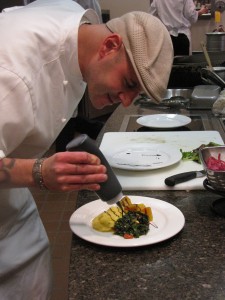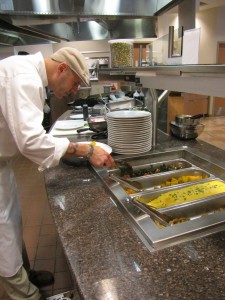 Park City Medical Center opened just over a year ago in Utah’s most famous ski town. Though it’s a hospital, the facility looks like an upscale resort, with river rock and exposed beams creating the out-west look popular in the area.
Park City Medical Center opened just over a year ago in Utah’s most famous ski town. Though it’s a hospital, the facility looks like an upscale resort, with river rock and exposed beams creating the out-west look popular in the area.
The luxury doesn’t end abruptly at the cafeteria’s doors, either. Typical dishes include spinach-ricotta ravioli in a cream sauce with grilled fennel and mushrooms, and Moroccan spiced lamb soup with kale and red lentils. This is the food that’s served to patients, too, in the belief that sick people can’t really heal if they’re being fed Jell-O and hamburgers in foil bags.
Sick people can’t really heal if they’re being fed Jell-O and hamburgers in foil bags.
Doctor Chef
The man running the kitchen, who started his career at Tavern on the Green in New York, is a member of the shaved head, fully tattooed bad-boy chef club. But Jason Kieffer is also a believer in holistic nutrition, and sources his produce as locally as possible and his meat from Niman Ranch.
“My path for the last 15 years has been doing what I do now. So the hospital knew I’d be bringing this approach. I have a lot of freedom to bring my food message, (and) they back me up,” says Kieffer.
Some hospitals – those lucky enough to have the resources, as Park City Medical does – are changing the way they look at food. “I spent sixteen years in Washington state, and two years ago I was asked to come help open this place up,” says Kieffer.  “I thought I would able to – and I did – tie in a holistic, natural approach to food and dining.”
“I thought I would able to – and I did – tie in a holistic, natural approach to food and dining.”
The chef tries to buy as much locally as he can. Though Utah isn’t an area known for year-round produce, Kieffer is making it work as best as possible. His baked goods are local, in the sense that the bagels are made down the street at Wasatch Bagels, and pastries are ordered from a woman in neighboring Salt Lake City, who custom-bakes items with ingredients like ground flax flour. He’s also recently teamed with Summit County Beef to buy shares of grass-fed cows. Such expenses add up, but removing the transportation costs saves money.
Hospital spokesperson Amy Roberts says that Kieffer “truly believes that your are what you eat, and he incorporates that into every recipe.” In the summer and fall he buys from farmers 10 minutes outside of Park City (“right now we’ve got local confetti carrots, squashes and potatoes”).
Kieffer has to run his kitchen within practical parameters. Sysco is his main purveyor, but he works with them to obtain items the company doesn’t generally carry, like organic canned vegetables, and whole grains such as quinoa and wheatberries.
“We use organic when possible, and we’re real big on a natural approach to food, so we try to avoid canned and frozen products. The biggest part of my kitchen is the storage, because of the dried beans and whole grains that we cook from the raw state. My crew members cook real food, they don’t open a #10 can, pour it out and reheat it.”
Better Food, Less Hospital Time?
In Santa Rosa, California, Linda Hansen, Director of Nutrition Services at St. Joseph Health System in Sonoma County, has changed her kitchens in much the same manner as Kieffer. “I’ve always wanted hospital food not like hospital food – you know, more like restaurant food. In 2005 or so, there was a summit to look at the health of food in health care. I had a vision of fresh and local and organic and getting to know local farmers. It was a new idea for me.”
Hospitals in cities like Park City and Santa Rosa – food-aware, more affluent communities – have a relatively easy time implementing this changes. Martin Sutter, a founding managing director of Essex Woodlands Health Ventures based in Texas who has recently been named to the Culinary Institute of America board of trustees, believes this change in hospital food is a good thing, but will take some time.
“Smaller, specialty hospitals are probably more at the forefront than the large hospitals. At the large ones… the focus is on adequate nutrition and the consistency of diet, rather than culinary taste. Trays of food tend to be held for a period of time before delivery. This makes for food that is relatively unappetizing. And there’s so much pressure today on hospitals to discharge patients that the greater emphasis is, bluntly, on getting patients home. There’s probably less of an emphasis on providing healing foods. And there’s the old joke, you know a patient’s feeling better when they start complaining about the food.”
“My crew members cook real food, they don’t open a #10 can, pour it out and reheat it.”–Jason Kieffer
Of course, the health of food sources might conceivably help the health of hospital patients, thus decreasing their time in a backless gown. Swedish Covenant Hospital in Chicago now only serves antibiotic-free meat. “There’s a lot of science to back up that this is the healthy thing to do. Antibiotic-free, that’s a huge thing right now that all the medical associations are endorsing,” says Hansen.
Little Changes Add Up
Her data speaks to small changes making a big impact. After switching from canned vegetables to fresh, she also instituted daily vegetarian entrees in her kitchens. “All of a sudden, 50% of our sales were vegetarian.” And these veggie-friendly meals had an unexpected, carnivore-friendly side effect: these savings gained from buying less animal protein enabled Hansen to start buying sustainable meat. “’Less meat, better meat,’ was kind of our tagline.” And the vegetarian meals aren’t too shabby, either: Dishes like spicy sesame noodles, risotto-stuffed acorn squash and asparagus-leek-gruyere quiche are in regular rotation.
Perhaps these hospitals can lead by example. Intermountain Healthcare, which owns Kieffer’s hospital, has 22 other hospitals in Utah and Idaho, with Park City the most luxurious location. The chefs and food service directors recently took a tour of Kieffer’s kitchen to see which of his ideas they might implement.

It’s hard work, but it is making a difference. In Santa Rosa, Hansen has received comments from repeat patients remarking on the improved quality of the food, while in Park City the cafeteria is seen as a legitimate dining destination among in-the-know locals. Even Martin Steele, who believes the medical-culinary revolution will come slowly, noticed something different when he was recently hospitalized in Michigan. “The meals were certainly a lot better than they were when I was in the hospital 20 years ago… and healthier too.”

Dayna forwarded your article to me. I loved “seeing you in print”. The hospital in which worked as a nurse made a board decision to make the food more like Resturant food. The patients loved tea and warm cookies in the afternoon. The menus changed. Over time the “tea time” disappeared as did the contemporary dishes. Best wishes to you. Bea
Hey the chef looks like Andy H. But he’s taller.